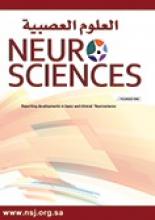Research ArticleOriginal Article
Open Access
Risk factors for cerebral edema following aneurysm clipping in patients with aneurysmal subarachnoid hemorrhage
Shifeng Xu, Baodong Chen, Hui Qi and Hongbin Liu
Neurosciences Journal April 2024, 29 (2) 90-95; DOI: https://doi.org/10.17712/nsj.2024.2.20230082
Shifeng Xu
From the Department of Neurosurgery, Peking University Shenzhen Hospital, Shenzhen, Guangdong Province, China
MBScBaodong Chen
From the Department of Neurosurgery, Peking University Shenzhen Hospital, Shenzhen, Guangdong Province, China
MDHui Qi
From the Department of Neurosurgery, Peking University Shenzhen Hospital, Shenzhen, Guangdong Province, China
MMHongbin Liu
From the Department of Neurosurgery, Peking University Shenzhen Hospital, Shenzhen, Guangdong Province, China
MD, medical degree
References
- 1.↵
- Sharma D.
- 2.↵
- 3.↵
- Fang Y,
- Lu J,
- Zheng J,
- Wu H,
- Araujo C,
- Reis C, et al.
- 4.↵
- Nathan SK,
- Brahme IS,
- Kashkoush AI,
- Anetakis K,
- Jankowitz BT,
- Thirumala PD.
- 5.↵
- 6.↵
- Qin B,
- Xiang Y,
- Zheng J,
- Xu R,
- Guo Z,
- Cheng C, et al.
- 7.↵
- Nguyen TA,
- Mai TD,
- Vu LD,
- Dao CX,
- Ngo HM,
- Hoang HB, et al.
- 8.↵
- Mittal AM,
- Pease M,
- McCarthy D,
- Legarreta A,
- Belkhir R,
- Crago EA, et al.
- 9.↵
- 10.↵
- Osgood ML.
- 11.↵
- Rouanet C,
- Silva GS.
- 12.↵
- Tawk RG,
- Hasan TF,
- D’Souza CE,
- Peel JB,
- Freeman WD.
- 13.↵
- Hu Q,
- Du Q,
- Yu W,
- Dong X.
- 14.↵
- 15.↵
- Molenberg R,
- Thio CHL,
- Aalbers MW,
- Uyttenboogaart M,
- Larsson SC,
- Bakker MK, et al.
- 16.↵
- Etminan N,
- Chang HS,
- Hackenberg K,
- de Rooij NK,
- Vergouwen MDI,
- Rinkel GJE, et al.
- 17.↵
- Rumalla K,
- Lin M,
- Ding L,
- Gaddis M,
- Giannotta SL,
- Attenello FJ, et al.
- 18.↵
- Zhao J,
- Jiang H,
- Jiang H,
- Meng Y,
- Gao R,
- Ma J, et al.
- 19.↵
- Di Russo P,
- Di Carlo DT,
- Lutenberg A,
- Morganti R,
- Evins AI,
- Perrini P.
- 20.↵
- Konczalla J,
- Seifert V,
- Beck J,
- Güresir E,
- Vatter H,
- Raabe A, et al.
- 21.↵
- Florez WA,
- García-Ballestas E,
- Deora H,
- Agrawal A,
- Martinez-Perez R,
- Galwankar S, et al.
- 22.↵
- Chen Y,
- Lian BQ,
- Peng L,
- Ding CY,
- Lin YX,
- Yu LH, et al.
- 23.↵
- Yuan Y,
- Chen J,
- Zhang Y,
- Zhao F,
- Zhai Y,
- Xu X, et al.
- 24.↵
- Darkwah Oppong M,
- Lohrer L,
- Wrede KH,
- Chihi M,
- Santos AN,
- Dammann P, et al.
- 25.↵
- Kuo LT,
- Huang AP.
- 26.↵
In this issue
Risk factors for cerebral edema following aneurysm clipping in patients with aneurysmal subarachnoid hemorrhage
Shifeng Xu, Baodong Chen, Hui Qi, Hongbin Liu
Neurosciences Journal Apr 2024, 29 (2) 90-95; DOI: 10.17712/nsj.2024.2.20230082
Jump to section
Related Articles
- No related articles found.





